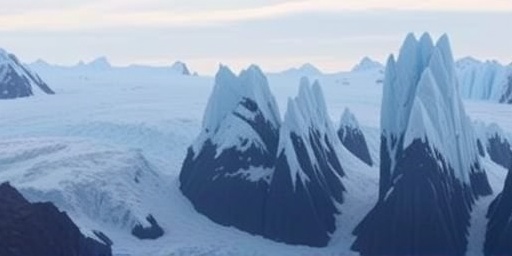Alarming Acceleration in Antarctic Ice Melt Shocks Scientists
In a stark revelation that underscores the escalating crisis of Climate change, new satellite data has uncovered that the Thwaites Glacier in Antarctica is melting at a rate 30% faster than previously predicted. This ‘Doomsday Glacier,’ as it’s ominously nicknamed due to its potential to trigger catastrophic sea level rise, is shedding ice at an unprecedented pace, according to researchers from NASA’s Jet Propulsion Laboratory and the British Antarctic Survey. The findings, published this week in the journal Nature Geoscience, are based on high-resolution imagery captured by the European Space Agency’s Sentinel-1 and NASA’s ICESat-2 satellites, which have been monitoring the region since 2016.
- Alarming Acceleration in Antarctic Ice Melt Shocks Scientists
- Satellite Innovations Reveal Hidden Dynamics of Thwaites Glacier’s Demise
- Global Sea Level Projections Escalate with Thwaites’ Rapid Retreat
- Expert Voices Demand Swift International Response to Antarctic Crisis
- Future Pathways: Mitigating the Thwaites Threat Before It’s Too Late
The acceleration is not just a minor blip; it’s a game-changer for global projections. Previously, models estimated Thwaites contributing about 4% to annual sea level rise, but the latest data suggests this could double within the decade if current trends persist. ‘This is a wake-up call we can’t ignore,’ said Dr. Emma Thompson, lead researcher on the project. ‘The ice melt is happening faster because warmer ocean waters are eroding the glacier’s underside, a process our satellites are now capturing in vivid detail.’
Thwaites Glacier, spanning roughly the size of Florida, holds enough ice to raise global sea levels by more than 65 centimeters (about 2 feet) if it collapses entirely. Its rapid retreat could destabilize neighboring ice sheets, amplifying the threat. This discovery comes at a critical juncture, as world leaders gather for the upcoming COP29 climate summit, where Antarctica‘s plight will undoubtedly dominate discussions.
Satellite Innovations Reveal Hidden Dynamics of Thwaites Glacier’s Demise
The breakthrough in this study hinges on advanced satellite technology that peers beneath the surface of Antarctica‘s vast ice fields. Traditional ground-based observations are limited by the continent’s extreme conditions—blizzards, sub-zero temperatures, and vast distances—but satellites like Sentinel-1 use radar to penetrate clouds and measure ice melt in real-time. ICESat-2, launched in 2018, employs laser altimetry to detect changes in ice height down to the centimeter level, providing unprecedented precision.
Analysis of data from 2023 shows that the glacier’s grounding line—the point where it lifts off the seabed—has retreated by over 2 kilometers since 2020, far exceeding earlier forecasts. This retreat exposes more of the glacier to warm circumpolar deep water, which is approximately 2-3 degrees Celsius above freezing and driven by Climate change-induced ocean warming. ‘Our satellites have essentially given us X-ray vision into the glacier’s vulnerabilities,’ explained Dr. Pieter De Rydt, a glaciologist at Durham University involved in the research. ‘What we’re seeing is basal melting rates hitting 100 meters per year in some areas—30% higher than the 75 meters we modeled just five years ago.’
These technological advancements aren’t isolated; they’ve been bolstered by AI-driven algorithms that process terabytes of satellite imagery daily. For instance, machine learning models trained on historical data from Landsat satellites help predict melt patterns, revealing that Thwaites’ western shear margin is fracturing more rapidly due to increased surface crevasses. This fracturing, captured in vivid detail by Sentinel-2’s optical sensors, indicates the glacier is losing its structural integrity, potentially leading to widespread calving of icebergs.
Historically, ice melt in Antarctica has been gradual, but the past decade has seen a sharp uptick. Between 1992 and 2017, the continent lost about 2,720 billion tonnes of ice, contributing 7.4 millimeters to global sea level rise, per IPCC reports. Thwaites alone accounted for a quarter of that loss in recent years, and the new data suggests this disproportionate contribution is intensifying. Experts warn that without intervention, this could accelerate Climate change feedback loops, where melting ice reduces Earth’s albedo (reflectivity), absorbing more solar heat and exacerbating the problem.
Global Sea Level Projections Escalate with Thwaites’ Rapid Retreat
The implications for sea level rise are profound and far-reaching. Current IPCC projections estimate a global rise of 0.28 to 0.55 meters by 2100 under moderate emissions scenarios, but Thwaites’ accelerated ice melt could add an extra 10-20 centimeters to those figures. Coastal cities like Miami, Shanghai, and Dhaka, already battling chronic flooding, face existential threats. In the U.S. alone, the National Oceanic and Atmospheric Administration (NOAA) predicts that sea level rise could cost $500 billion in damages by mid-century, displacing millions.
Take Bangladesh, for example: home to 160 million people, much of it on low-lying deltas. A 30% faster melt rate from Thwaites could inundate 20% more land than anticipated, affecting agricultural heartlands and freshwater supplies. ‘We’re talking about billions of lives disrupted,’ said Professor Jason Box, a climate scientist at the Geological Survey of Denmark and Greenland. ‘ Antarctica‘s ice melt isn’t a distant problem; it’s reshaping our coastlines today.’
Statistics paint a grim picture: Since 1900, global sea levels have risen 20-25 centimeters, with the rate doubling in the last 30 years to 3.7 millimeters annually. Satellites from the TOPEX/Poseidon and Jason series have tracked this meticulously, showing that Antarctic contributions have surged from negligible to 40% of the total since 2010. Thwaites’ role is pivotal; its instability could trigger a domino effect across the West Antarctic Ice Sheet, potentially unlocking enough ice for a 3-meter rise over centuries.
Moreover, the socioeconomic ripple effects are staggering. Insurance premiums in flood-prone areas have skyrocketed—up 30% in Florida since 2020—and governments are scrambling to fund defenses like the Netherlands’ Delta Works expansion. Yet, these are stopgaps; the root cause lies in climate change, fueled by greenhouse gas emissions. The new satellite data emphasizes the urgency: every degree of warming amplifies ice melt by 10-15%, per modeling from the Potsdam Institute for Climate Impact Research.
Expert Voices Demand Swift International Response to Antarctic Crisis
As the data from satellites floods in, a chorus of experts is calling for immediate global action. At a press conference in London, Dr. Thompson urged the international community to prioritize Antarctica in climate policies. ‘We’ve invested billions in satellites for monitoring—now we must match that with emissions cuts and adaptation funding,’ she stated. The Antarctic Treaty System, which governs the continent, could be leveraged for enhanced research collaborations, but enforcement of emissions targets remains elusive.
Environmental organizations like Greenpeace and the World Wildlife Fund have amplified the call, launching campaigns to pressure G20 nations. ‘The Thwaites findings are a red flag for climate change denial,’ said campaign director Lila Patel. ‘We need binding agreements to phase out fossil fuels by 2035, or sea level rise will overwhelm vulnerable populations.’
Scientists propose practical steps: expanding satellite constellations for continuous monitoring, investing in sub-ice ocean sensors, and modeling worst-case scenarios for urban planning. The U.S. has pledged $2 billion to Antarctic research under the Biden administration, while the EU’s Horizon Europe program allocates €100 million for ice melt studies. However, critics argue these efforts fall short without broader decarbonization. ‘Technology alone won’t save us; policy must catch up,’ noted Dr. De Rydt.
Public awareness is also ramping up. Documentaries like ‘Ice on Fire’ and viral social media posts featuring satellite visuals of cracking glaciers are educating the masses. Schools in coastal regions are incorporating Thwaites’ story into curricula, fostering a new generation of climate advocates.
Future Pathways: Mitigating the Thwaites Threat Before It’s Too Late
Looking ahead, the path forward demands innovation and resolve. Researchers are exploring geoengineering ideas, such as deploying underwater curtains to block warm water from Thwaites’ base, though ethical and ecological risks loom large. More realistically, achieving net-zero emissions by 2050 could halve the projected ice melt rates, buying time for adaptation.
International forums like the UN’s Ocean Conference in 2025 will likely feature Thwaites prominently, pushing for a ‘Antarctic Protection Protocol’ to safeguard the region. Meanwhile, satellites will continue their vigilant watch, with next-gen missions like NASA’s NISAR set to launch in 2024, offering even finer resolution on Antarctica‘s dynamics.
The stakes are clear: unchecked climate change could turn Thwaites from a warning into a catastrophe, reshaping sea levels and human habitats irreversibly. Yet, history shows humanity’s capacity for change—from the Montreal Protocol’s ozone success to renewable energy booms. With concerted action, the Doomsday Glacier’s prophecy can be averted, securing a stable future for generations to come.









